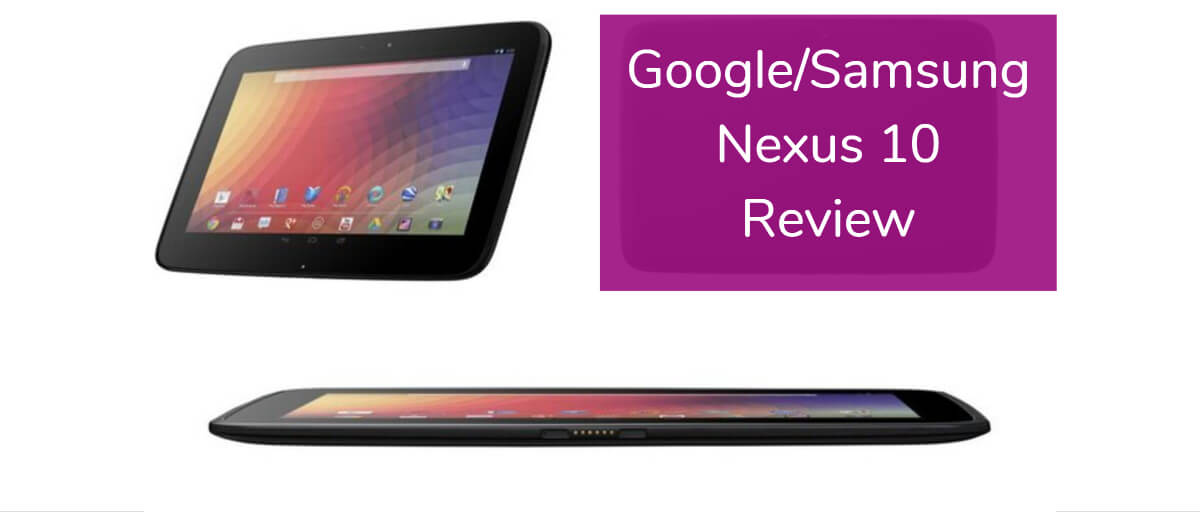Table of Contents
Last Updated on March 29, 2020
When it was first announced, the Google Nexus 10 tablet appeared to be little more than a desperate catch-up attempt after Apple’s iPad dominance. Now that the release has finally come, the Samsung-built Nexus 10 has proven to be much more.
While it’s likely that the iPad’s sizable advantage isn’t going to disappear overnight, Google looks to have hit the right notes once again with its venture into 10-inch tablets. Nexus is here to stay.
See the Google Nexus 10 on Amazon
Nexus 10 Look and Feel
The Nexus 10 has clearly taken a lesson from the iPad and put great focus into the overall feel of the tablet. Rather than off-putting sharp edges and corners, there are curves galore.
The rubber back is smooth and comfortable to the touch, while still maintaining enough of a stickiness to prevent any feeling of finger-slip. The dimensions, too, make for a comfortable experience. At 10.39 inches by 6.99 inches and 0.35 inches in thickness, the Nexus feels natural to hold and operate.
It’s also fairly light at 1.33 pounds, making it much less tiring to hold for long periods.
Exterior
The Nexus 10 features only two physical controls. A volume rocker is located along the top left edge, a rather unusual spot for the volume control. A power button is located next to it, and it also serves as a lock button.
Along the left edge is a 3.5-millimeter headphone jack, along with a micro-USB port used for charging. The bottom sports a magnetic pogo port, and a micro-HDMI port can be found on the right edge. Flanking the device’s display is one of its most celebrated features, a pair of front-facing speakers built into a plastic bezel.
A 1.9-megapixel camera capable of 720p video completes the front, and it’s joined on the rear by a 5-megapixel camera with full 1080p capability.
Display
For a device intended largely for media consumption, the display naturally becomes a focal point. To this end, the Google Nexus 10 excels. The striking display, built from Corning’s Gorilla Glass 2, boasts a gaudy 2,560 by 1,600-pixel, 10.1-inch display.
The tablet’s ultra-high resolution and 300 pixels per inch are the best on the market today, even beating out the latest offering from Apple. Colors are bright and vivid, and the clarity is simply stunning.
The only nitpick about the display is that contrast is sometimes lacking, which is made all the more noticeable because of the otherwise stellar picture.
Under the Hood
Running the Nexus 10 is a 1.7-gigahertz Samsung Exynos processor and two gigabytes of RAM.
The dual-core Exynos 5250 may seem an odd choice considering the recent proliferation of quad-core processors among tablets, but it performs well. Overall the tablet is consistently smooth, delivering performance comparable to many of the quad-core chips of its competitors.
The Nexus does have an obvious weakness, however, in its lack of storage space. The Nexus 10 offers a choice of 16 or 32 gigabytes, though system files and other necessary items occupy a few of those gigabytes right off the bat.
This suggests that Google fully expects users to rely on cloud storage and streaming options, which could turn some would-be buyers off.
Competitor Roundup
The Google Nexus 10 is an impressive piece of technology, but its glorious display alone may not be quite enough to sway buyers.
Comparing to Android-powered tablets, the ASUS Transformer Pad Infinity TF700 and the Samsung Galaxy Note 10.1 both offer stiff competition to the Nexus. Neither has the resolution or pixels per inch to compete with its display, but the TF700 offers better overall performance, battery life, display contrast, and cameras, as well as similar comfort and usability.
The Galaxy Note 10.1 offers excellent quad-core performance, an improved range of storage options and a comparable comfort level, but the higher price point may dissuade more budget-minded shoppers.

